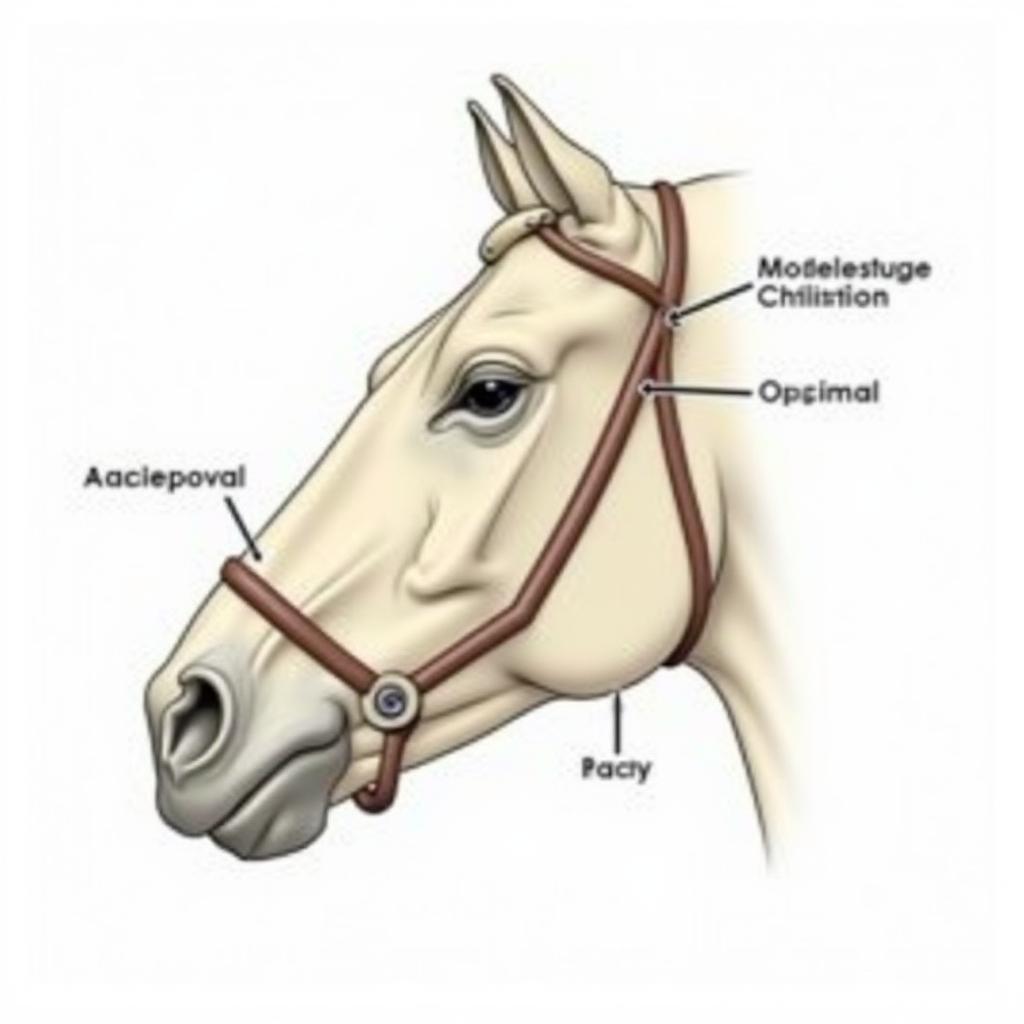The Atlas Of Horse is a crucial area of equine anatomy, impacting everything from movement to overall well-being. Understanding this complex structure is essential for horse owners, riders, and anyone involved in equine care. This guide will delve into the intricacies of the horse’s atlas, covering its function, common issues, and best practices for maintaining its health.
 Horse Atlas Anatomy: Detailed view of the atlas bone in a horse's skeletal structure, showcasing its unique ring-like shape and connection to the skull and axis bone.
Horse Atlas Anatomy: Detailed view of the atlas bone in a horse's skeletal structure, showcasing its unique ring-like shape and connection to the skull and axis bone.
Understanding the Horse’s Atlas: Structure and Function
The atlas, also known as the first cervical vertebra (C1), sits directly behind the skull and forms the atlanto-occipital joint. Unlike other vertebrae, the atlas is ring-shaped, lacking a vertebral body. This unique structure allows for the up-and-down movement of the head, enabling the horse to nod “yes.” The atlas connects to the axis (C2), the second cervical vertebra, facilitating the side-to-side, or “no,” motion. This complex interplay of bones and joints allows for a wide range of head movement essential for grazing, communication, and balance. horse anatomy neck provides additional information on the overall neck structure.
Why is the Atlas so Important?
The atlas plays a vital role in supporting the head, protecting the spinal cord, and facilitating crucial neurological pathways. Damage or misalignment of the atlas can lead to a variety of problems, affecting the horse’s movement, balance, and even neurological function.
- Supports the weight of the head
- Protects the spinal cord
- Facilitates head movement
Common Issues Affecting the Atlas
Several factors can affect the health and function of the horse’s atlas. Trauma, such as falls or collisions, can cause fractures or dislocations. Developmental issues, especially in young horses, can also lead to abnormalities in the atlas. Furthermore, poor posture, ill-fitting tack, and dental problems can contribute to misalignment and pain in the atlanto-occipital and atlanto-axial joints.
What are the signs of Atlas problems?
- Stiffness and reluctance to move the head
- Difficulty with balance and coordination
- Neurological signs, such as stumbling or weakness
- Pain and sensitivity in the neck area
“A healthy atlas is fundamental to a horse’s overall well-being,” says Dr. Emily Carter, DVM, specializing in equine sports medicine. “Regular chiropractic care and proper riding techniques can help maintain its health and prevent potential issues.”
Maintaining a Healthy Atlas
Maintaining a healthy atlas requires a multi-faceted approach. Regular veterinary checkups, including chiropractic evaluations, can help identify and address potential problems early on. Proper riding techniques, including correct posture and balanced riding, can minimize strain on the atlas. Ensuring a comfortable and well-fitting bridle and saddle is also crucial for preventing pressure points and misalignment.
How can I support my horse’s Atlas health?
- Regular veterinary checkups
- Chiropractic care
- Correct riding techniques
- Proper tack fit
- Dental care
“Early intervention is key when it comes to atlas issues,” adds Dr. Carter. “Addressing problems early can significantly improve the horse’s prognosis and prevent long-term complications.”
diomedes devoured by horses offers a stark reminder of the power and vulnerability of horses. 1800s horse names explores the historical connection between humans and horses.
Conclusion
The atlas of horse is a vital component of its anatomy, playing a critical role in head movement, balance, and overall well-being. Understanding its structure, function, and potential issues is essential for responsible horse ownership and care. By prioritizing preventative measures and seeking professional guidance when needed, we can ensure the long-term health and happiness of our equine companions. Implementing proper care and attention to the atlas will ensure your horse remains comfortable and able to perform at its best.
FAQ
- What is the atlas in a horse?
- What are the common signs of atlas problems in horses?
- How can I prevent atlas issues in my horse?
- What is the role of chiropractic care in maintaining a healthy atlas?
- How can a poorly fitting saddle affect the horse’s atlas?
- What are the long-term consequences of untreated atlas problems?
- How can I tell if my horse’s atlas is misaligned?
Scenarios
Scenario 1: A horse exhibits stiffness and reluctance to turn its head, especially during riding. This could indicate a potential issue with the atlas and warrants a veterinary examination.
Scenario 2: A young horse experiences difficulty with balance and coordination. Developmental abnormalities in the atlas could be a contributing factor, requiring further investigation.
Scenario 3: A horse shows signs of neurological dysfunction, such as stumbling or weakness. This could be related to a problem with the atlas and necessitates immediate veterinary attention.
Further Reading and Resources
- Explore more about horse anatomy.
- Learn about equine chiropractic care.
- Find out more about proper saddle fitting.
When you need assistance, contact us: Phone: 0772127271, Email: [email protected] Or visit us at: QGM2+WX2, Vị Trung, Vị Thuỷ, Hậu Giang, Việt Nam. We have a 24/7 customer service team.